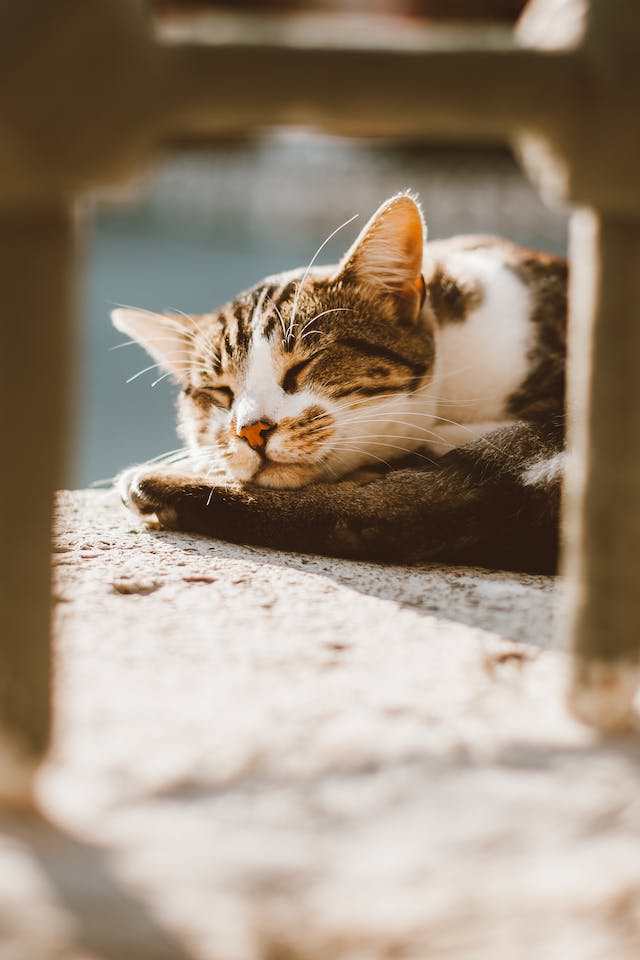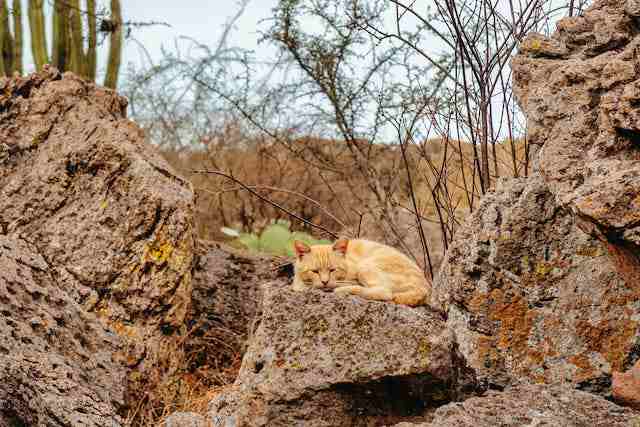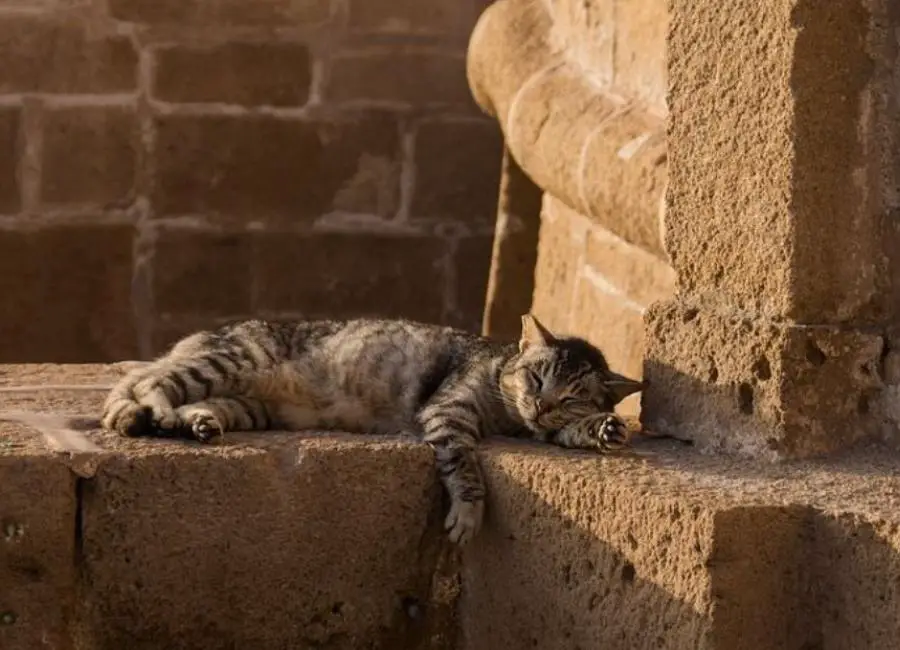Where do feral cats sleep? Let’s find out together…
Ever wondered where those elusive feral cats get their beauty sleep? Well, get ready to unravel the mystery because today we’re diving into the secret hideouts and cozy spots that feral cats call their own.
So, grab a cup of coffee, sit back, and let’s uncover the nocturnal world of feline slumber!
Where Do Feral Cats Sleep
Feral cats are resourceful and often find several safe and warm locations to sleep.
Feral cats usually seek out secluded spots, such as under bushes, in abandoned buildings, or in the hollows of trees where they can stay hidden from predators.
They also prefer places that provide shelter from harsh weather conditions, like under cars or within dense vegetation.
However, their sleeping location can change frequently based on perceived threats in the environment.
Let’s dive deeper…
Places Where Feral Cats Sleep

Here are some of the most common where feral cats sleep:
1. Under Park Benches or Picnic Tables
Feral cats often seek shelter under park benches or picnic tables due to the protection they offer.
The space beneath these structures provides a covered area that shields the cats from rain, wind, and direct sunlight.
Additionally, the low heights of benches and tables make them easily accessible to cats.
These areas can also provide a sense of security for feral cats, as they can observe their surroundings while remaining hidden.
2. Abandoned and Dilapidated Buildings
Abandoned and dilapidated buildings attract feral cats as they provide ample hiding spots and protection from the elements.
Cats are skilled at finding small openings or gaps in walls, broken windows, or other entry points that allow them to access these structures.
Once inside, they may choose to sleep in secluded corners, crawl spaces, or even on old furniture or debris.
The decaying structures offer a measure of privacy and security, shielding feral cats from the outside world.
3. Under Porches or Decks
Under porches or decks is another common spot for feral cats to seek refuge.
These areas provide a dark, enclosed space that offers protection from the elements and potential predators.
The proximity to human dwellings can provide some warmth, as the structures block wind and retain heat.
Feral cats may enter these spaces through gaps or openings in the structure’s foundation or through crawl spaces.
The underside of porches and decks often remains cool during hot weather, making it an appealing spot for feral cats to rest.
4. Inside Empty Boxes or Containers
Feral cats are naturally drawn to enclosed spaces because they provide a sense of security and protection.
Empty boxes or containers, such as discarded cardboard boxes or crates, offer feral cats a hidden and sheltered area where they can rest undisturbed.
The confined space helps them feel safe from potential predators and provides insulation against the elements.
The boxes or containers also provide a cozy, warm spot for cats to curl up in, retaining their body heat.
5. Bushes and Overgrown Vegetation
Feral cats often seek refuge in bushes and overgrown vegetation as these areas offer natural cover.
The dense foliage provides a shield from wind, rain, and direct sunlight. Cats can find a cozy nook among the branches, leaves, and tall grass, which helps regulate their body temperature and protects them from harsh weather conditions.
The vegetation also serves as camouflage, making it easier for cats to remain hidden from predators and other potential threats.
6. Parked Vehicles
Feral cats may take shelter underneath parked vehicles, particularly during colder months or inclement weather.
The warmth generated by car engines after they have been turned off can be enticing to cats seeking a warm spot.
The undercarriage of vehicles provides an elevated and enclosed space that offers protection from rain, wind, and other outdoor elements.
Cats can also find safety from predators as well as observe their surroundings from this vantage point.
However, it’s important to note that this behavior can be dangerous for cats, as they may be injured or killed if the vehicle is started or moved unknowingly. It’s crucial for vehicle owners to check for the presence of cats before starting their engines.
7. Barns and Sheds

Barns and sheds are popular sleeping spots for feral cats due to their enclosed structure, which offers protection from the elements such as rain, wind, and extreme temperatures.
These structures also provide a level of privacy, reducing the chances of encounters with predators or humans.
Feral cats may find cozy spots in the corners, on top of hay bales, or even inside old equipment.
Additionally, barns and sheds often attract rodents, which can serve as a potential food source for the cats.
8. Under Dumpsters or Trash Piles
Feral cats are known to seek shelter under dumpsters or in piles of trash. While these locations may seem unappealing to humans, they offer feral cats a hiding place where they can feel secure and hidden from predators.
The warmth generated by decomposing materials can also provide some insulation during colder months.
Moreover, dumpsters near restaurants or food establishments may provide a source of discarded food, making it an attractive spot for feral cats to sleep and scavenge for meals.
9. Treetops or High Platforms
Feral cats are natural climbers and possess impressive agility. They are often seen sleeping in treetops or on high platforms, such as rooftops or balconies.
These elevated locations offer a vantage point that allows them to survey their surroundings and detect potential threats from a safe distance.
Sleeping in treetops also provides feral cats with protection from ground-dwelling predators.
Additionally, being above ground level keeps them away from damp or cold surfaces, ensuring a dry and comfortable sleeping spot.
10. Behind Appliances or Machinery
Feral cats often seek out small, enclosed spaces for sleeping, and the areas behind appliances or machinery can provide this type of shelter.
These spaces are typically cool, dark, and relatively quiet, offering a sense of security.
Cats may choose to sleep behind refrigerators, washing machines, or air conditioning units because these areas are less likely to be disturbed by humans or other animals.
The warmth generated by the machinery can also provide additional comfort, especially during colder months.
11. Porch Furniture or Cushions
Feral cats may find porch furniture or cushions to be a suitable place to sleep.
Porch furniture, such as chairs or benches, can provide a raised and comfortable surface for them to rest on. Cushions and upholstery materials offer a soft and cozy spot for cats to curl up.
Additionally, if the furniture is located on a covered porch or under a roof, it can provide some protection from rain or direct sunlight, making it an appealing sleeping spot.
Read more about why cats disappear without a trace.
12. Along Abandoned Track Roads

Feral cats often seek out areas with minimal human activity and ample hiding spots, and abandoned track roads can fulfill these criteria.
These roads are typically overgrown with vegetation, offering cats the opportunity to hide and sleep undisturbed.
The dense foliage provides cover and protection from predators, while the road itself may provide a warm surface for cats to rest on.
Abandoned track roads are often secluded and quiet, making them a desirable location for feral cats to find solitude and safety.
Read more about why cats hang around your house.
Frequently Asked Questions
Where do feral cats sleep?
Feral cats are resourceful and adaptable creatures. They can sleep in a variety of places, such as abandoned buildings, under bushes, in dense foliage, or even in old cars. They seek out sheltered spots that provide protection from the elements and potential predators.
Read more about why cats run away.
Do feral cats make their own shelters?
Yes, feral cats are skilled at finding or creating makeshift shelters. They may dig burrows in the ground, use hollowed-out tree trunks, or find cozy spots in abandoned structures. They rely on their instincts to find safe and comfortable places to sleep.
Can feral cats sleep in trees?
Although feral cats are agile climbers, they typically prefer to sleep closer to the ground. While it’s not impossible for them to sleep in trees, it’s less common. They tend to choose more secure locations that offer better protection and concealment.
Do feral cats sleep alone or in groups?
Feral cats are generally solitary animals, and they often prefer to sleep alone. However, it’s not uncommon to find small groups of feral cats, especially if they’re from the same litter or have formed social bonds. These groups may sleep in close proximity to one another for added security.
Read more about the dangers outdoor cats face.
What can I do to provide shelter for feral cats?
If you’re concerned about the well-being of feral cats in your area, you can help by providing shelter options. Building or purchasing outdoor cat shelters, such as insulated boxes or cozy huts, can offer feral cats a safe place to sleep. Placing them in quiet, secluded areas can attract them to use the shelters.
Should I feed feral cats near their sleeping area?
It’s generally recommended to place food and water stations away from where feral cats sleep. This helps prevent attracting unwanted attention from predators and keeps their sleeping spots more discreet. It’s best to create separate feeding areas that are accessible but not too close to their shelters.
Read more about why your cat might be missing for a week.
Conclusion
In conclusion, feral cats find comfort and shelter in various places, adapting to their environment for survival. Whether it’s a cozy nook in an abandoned building, a hidden spot in the bushes, or even a discarded box, these resourceful felines make the best of their circumstances. So next time you come across a feral cat, remember that they have their own secret hideouts where they rest, dream, and navigate the world on their own terms.


